Agile and Traditional Methods: Project Management Comparison Report
VerifiedAdded on 2019/12/28
|8
|3479
|166
Report
AI Summary
This report provides a comprehensive comparison between Agile and traditional project management methodologies, focusing on their application within the IT industry. It explores the core principles of Agile, emphasizing incremental software delivery and customer satisfaction, while contrasting it with the traditional Waterfall model. The report examines the benefits of Agile, such as improved software quality, reduced project risk, and enhanced project visibility. It also addresses the challenges associated with Agile adoption, including the need for skilled teams, effective customer collaboration, and organizational culture shifts. The analysis includes discussions of empirical process control, the limitations of the Waterfall model, and techniques for addressing these limitations through Agile practices. The report highlights the importance of adaptability, continuous monitoring, and iterative development in achieving successful project outcomes, ultimately providing insights into the strengths and weaknesses of both approaches.
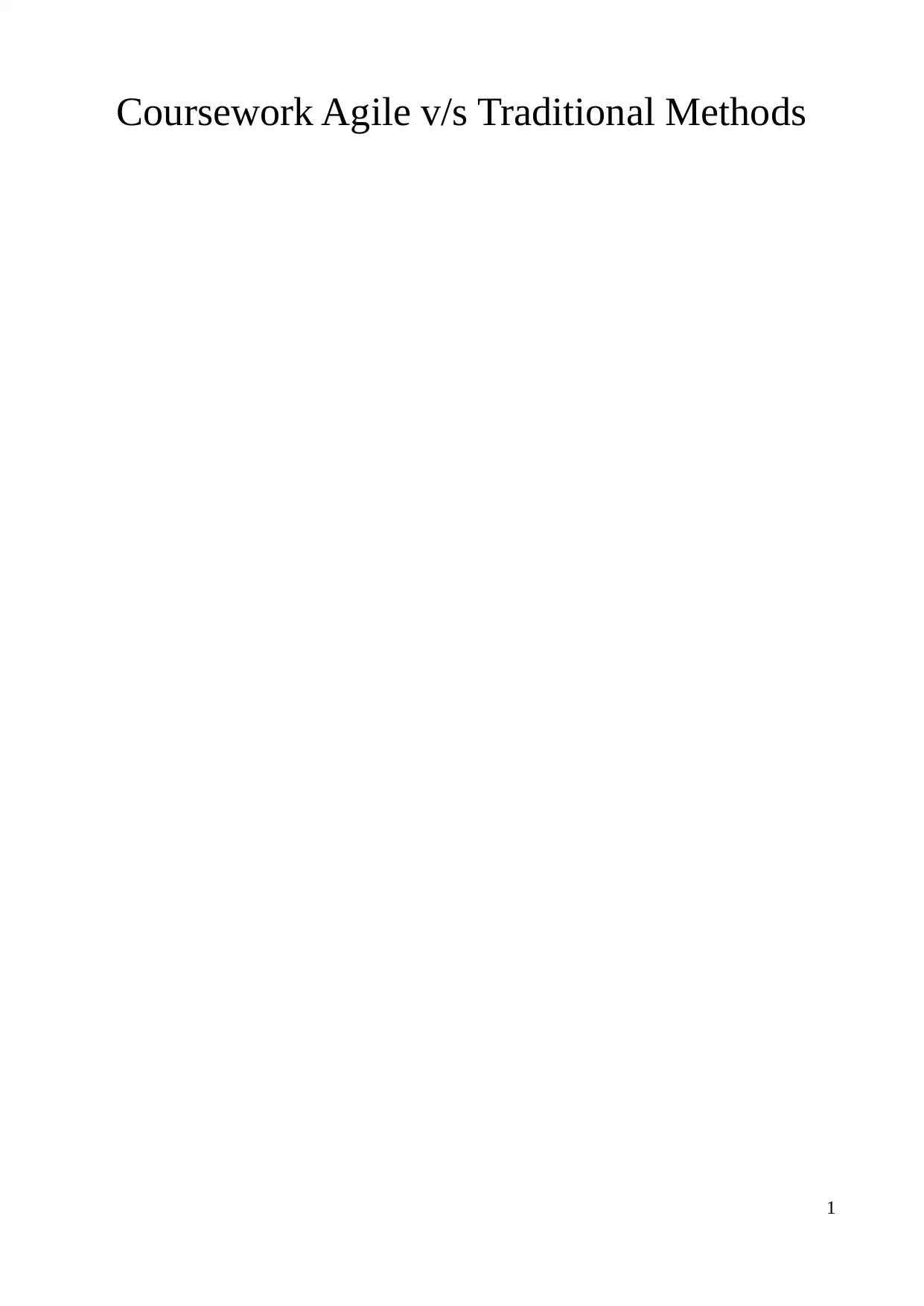
Coursework Agile v/s Traditional Methods
1
1
Paraphrase This Document
Need a fresh take? Get an instant paraphrase of this document with our AI Paraphraser
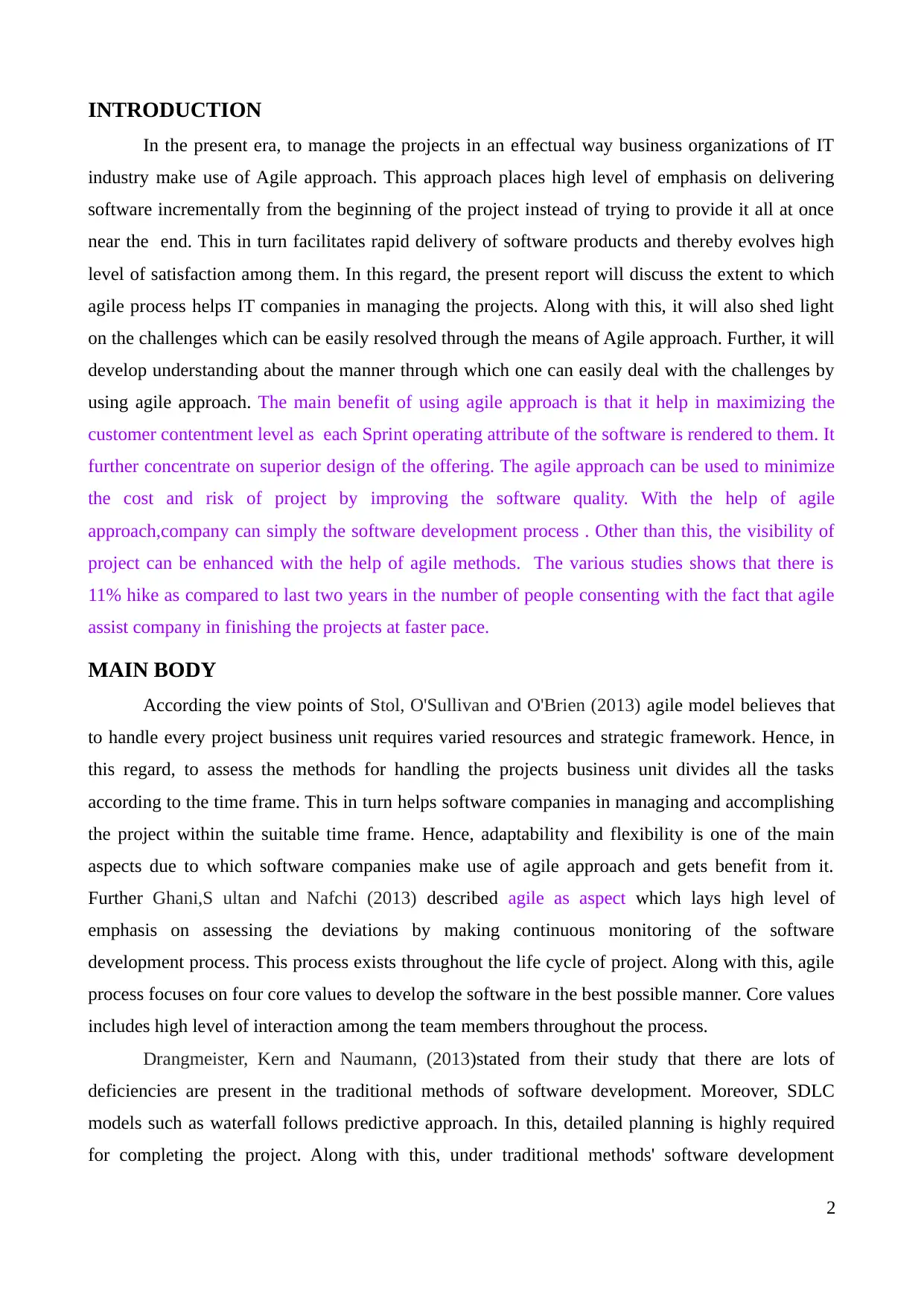
INTRODUCTION
In the present era, to manage the projects in an effectual way business organizations of IT
industry make use of Agile approach. This approach places high level of emphasis on delivering
software incrementally from the beginning of the project instead of trying to provide it all at once
near the end. This in turn facilitates rapid delivery of software products and thereby evolves high
level of satisfaction among them. In this regard, the present report will discuss the extent to which
agile process helps IT companies in managing the projects. Along with this, it will also shed light
on the challenges which can be easily resolved through the means of Agile approach. Further, it will
develop understanding about the manner through which one can easily deal with the challenges by
using agile approach. The main benefit of using agile approach is that it help in maximizing the
customer contentment level as each Sprint operating attribute of the software is rendered to them. It
further concentrate on superior design of the offering. The agile approach can be used to minimize
the cost and risk of project by improving the software quality. With the help of agile
approach,company can simply the software development process . Other than this, the visibility of
project can be enhanced with the help of agile methods. The various studies shows that there is
11% hike as compared to last two years in the number of people consenting with the fact that agile
assist company in finishing the projects at faster pace.
MAIN BODY
According the view points of Stol, O'Sullivan and O'Brien (2013) agile model believes that
to handle every project business unit requires varied resources and strategic framework. Hence, in
this regard, to assess the methods for handling the projects business unit divides all the tasks
according to the time frame. This in turn helps software companies in managing and accomplishing
the project within the suitable time frame. Hence, adaptability and flexibility is one of the main
aspects due to which software companies make use of agile approach and gets benefit from it.
Further Ghani,S ultan and Nafchi (2013) described agile as aspect which lays high level of
emphasis on assessing the deviations by making continuous monitoring of the software
development process. This process exists throughout the life cycle of project. Along with this, agile
process focuses on four core values to develop the software in the best possible manner. Core values
includes high level of interaction among the team members throughout the process.
Drangmeister, Kern and Naumann, (2013)stated from their study that there are lots of
deficiencies are present in the traditional methods of software development. Moreover, SDLC
models such as waterfall follows predictive approach. In this, detailed planning is highly required
for completing the project. Along with this, under traditional methods' software development
2
In the present era, to manage the projects in an effectual way business organizations of IT
industry make use of Agile approach. This approach places high level of emphasis on delivering
software incrementally from the beginning of the project instead of trying to provide it all at once
near the end. This in turn facilitates rapid delivery of software products and thereby evolves high
level of satisfaction among them. In this regard, the present report will discuss the extent to which
agile process helps IT companies in managing the projects. Along with this, it will also shed light
on the challenges which can be easily resolved through the means of Agile approach. Further, it will
develop understanding about the manner through which one can easily deal with the challenges by
using agile approach. The main benefit of using agile approach is that it help in maximizing the
customer contentment level as each Sprint operating attribute of the software is rendered to them. It
further concentrate on superior design of the offering. The agile approach can be used to minimize
the cost and risk of project by improving the software quality. With the help of agile
approach,company can simply the software development process . Other than this, the visibility of
project can be enhanced with the help of agile methods. The various studies shows that there is
11% hike as compared to last two years in the number of people consenting with the fact that agile
assist company in finishing the projects at faster pace.
MAIN BODY
According the view points of Stol, O'Sullivan and O'Brien (2013) agile model believes that
to handle every project business unit requires varied resources and strategic framework. Hence, in
this regard, to assess the methods for handling the projects business unit divides all the tasks
according to the time frame. This in turn helps software companies in managing and accomplishing
the project within the suitable time frame. Hence, adaptability and flexibility is one of the main
aspects due to which software companies make use of agile approach and gets benefit from it.
Further Ghani,S ultan and Nafchi (2013) described agile as aspect which lays high level of
emphasis on assessing the deviations by making continuous monitoring of the software
development process. This process exists throughout the life cycle of project. Along with this, agile
process focuses on four core values to develop the software in the best possible manner. Core values
includes high level of interaction among the team members throughout the process.
Drangmeister, Kern and Naumann, (2013)stated from their study that there are lots of
deficiencies are present in the traditional methods of software development. Moreover, SDLC
models such as waterfall follows predictive approach. In this, detailed planning is highly required
for completing the project. Along with this, under traditional methods' software development
2
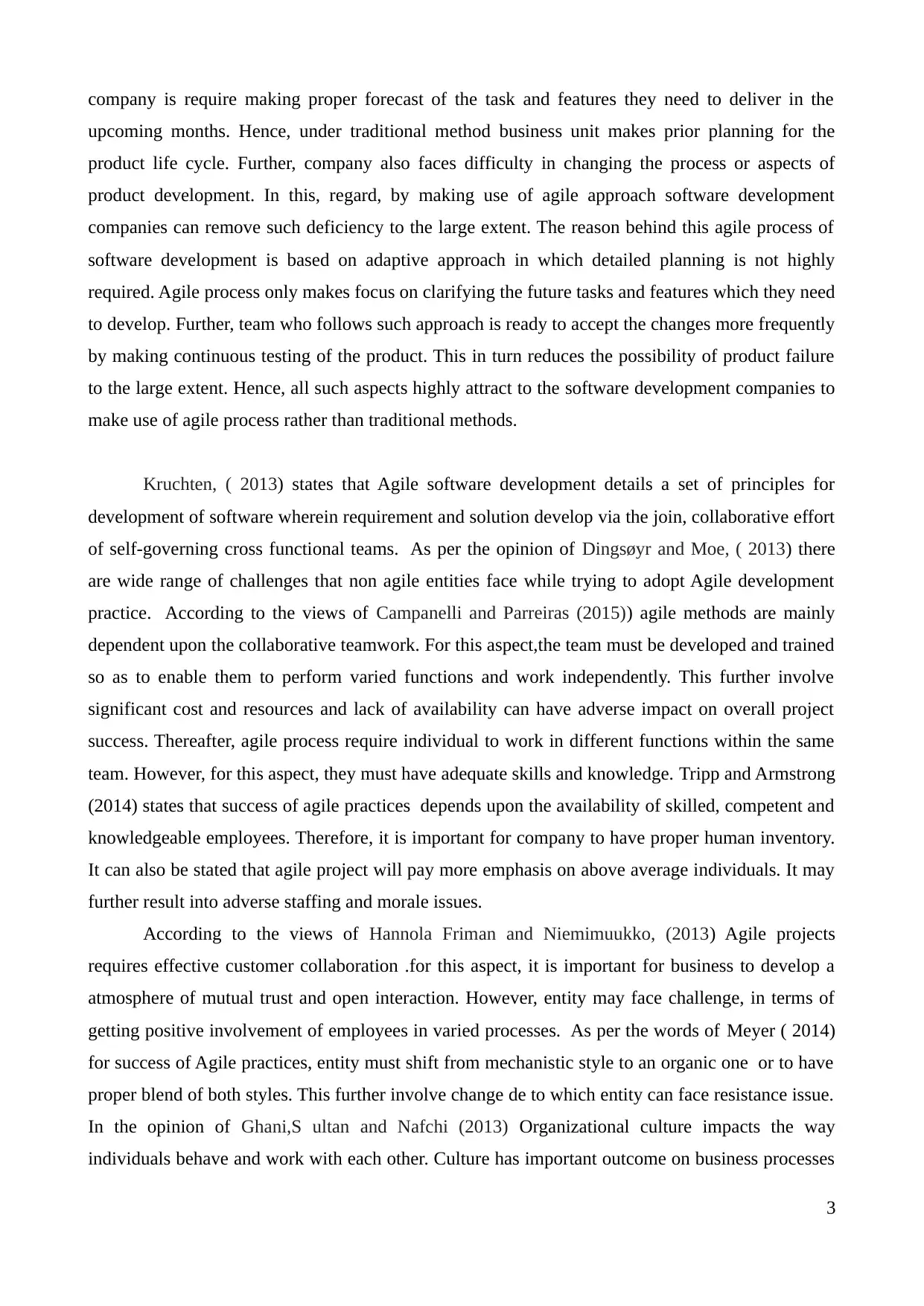
company is require making proper forecast of the task and features they need to deliver in the
upcoming months. Hence, under traditional method business unit makes prior planning for the
product life cycle. Further, company also faces difficulty in changing the process or aspects of
product development. In this, regard, by making use of agile approach software development
companies can remove such deficiency to the large extent. The reason behind this agile process of
software development is based on adaptive approach in which detailed planning is not highly
required. Agile process only makes focus on clarifying the future tasks and features which they need
to develop. Further, team who follows such approach is ready to accept the changes more frequently
by making continuous testing of the product. This in turn reduces the possibility of product failure
to the large extent. Hence, all such aspects highly attract to the software development companies to
make use of agile process rather than traditional methods.
Kruchten, ( 2013) states that Agile software development details a set of principles for
development of software wherein requirement and solution develop via the join, collaborative effort
of self-governing cross functional teams. As per the opinion of Dingsøyr and Moe, ( 2013) there
are wide range of challenges that non agile entities face while trying to adopt Agile development
practice. According to the views of Campanelli and Parreiras (2015)) agile methods are mainly
dependent upon the collaborative teamwork. For this aspect,the team must be developed and trained
so as to enable them to perform varied functions and work independently. This further involve
significant cost and resources and lack of availability can have adverse impact on overall project
success. Thereafter, agile process require individual to work in different functions within the same
team. However, for this aspect, they must have adequate skills and knowledge. Tripp and Armstrong
(2014) states that success of agile practices depends upon the availability of skilled, competent and
knowledgeable employees. Therefore, it is important for company to have proper human inventory.
It can also be stated that agile project will pay more emphasis on above average individuals. It may
further result into adverse staffing and morale issues.
According to the views of Hannola Friman and Niemimuukko, (2013) Agile projects
requires effective customer collaboration .for this aspect, it is important for business to develop a
atmosphere of mutual trust and open interaction. However, entity may face challenge, in terms of
getting positive involvement of employees in varied processes. As per the words of Meyer ( 2014)
for success of Agile practices, entity must shift from mechanistic style to an organic one or to have
proper blend of both styles. This further involve change de to which entity can face resistance issue.
In the opinion of Ghani,S ultan and Nafchi (2013) Organizational culture impacts the way
individuals behave and work with each other. Culture has important outcome on business processes
3
upcoming months. Hence, under traditional method business unit makes prior planning for the
product life cycle. Further, company also faces difficulty in changing the process or aspects of
product development. In this, regard, by making use of agile approach software development
companies can remove such deficiency to the large extent. The reason behind this agile process of
software development is based on adaptive approach in which detailed planning is not highly
required. Agile process only makes focus on clarifying the future tasks and features which they need
to develop. Further, team who follows such approach is ready to accept the changes more frequently
by making continuous testing of the product. This in turn reduces the possibility of product failure
to the large extent. Hence, all such aspects highly attract to the software development companies to
make use of agile process rather than traditional methods.
Kruchten, ( 2013) states that Agile software development details a set of principles for
development of software wherein requirement and solution develop via the join, collaborative effort
of self-governing cross functional teams. As per the opinion of Dingsøyr and Moe, ( 2013) there
are wide range of challenges that non agile entities face while trying to adopt Agile development
practice. According to the views of Campanelli and Parreiras (2015)) agile methods are mainly
dependent upon the collaborative teamwork. For this aspect,the team must be developed and trained
so as to enable them to perform varied functions and work independently. This further involve
significant cost and resources and lack of availability can have adverse impact on overall project
success. Thereafter, agile process require individual to work in different functions within the same
team. However, for this aspect, they must have adequate skills and knowledge. Tripp and Armstrong
(2014) states that success of agile practices depends upon the availability of skilled, competent and
knowledgeable employees. Therefore, it is important for company to have proper human inventory.
It can also be stated that agile project will pay more emphasis on above average individuals. It may
further result into adverse staffing and morale issues.
According to the views of Hannola Friman and Niemimuukko, (2013) Agile projects
requires effective customer collaboration .for this aspect, it is important for business to develop a
atmosphere of mutual trust and open interaction. However, entity may face challenge, in terms of
getting positive involvement of employees in varied processes. As per the words of Meyer ( 2014)
for success of Agile practices, entity must shift from mechanistic style to an organic one or to have
proper blend of both styles. This further involve change de to which entity can face resistance issue.
In the opinion of Ghani,S ultan and Nafchi (2013) Organizational culture impacts the way
individuals behave and work with each other. Culture has important outcome on business processes
3
⊘ This is a preview!⊘
Do you want full access?
Subscribe today to unlock all pages.

Trusted by 1+ million students worldwide
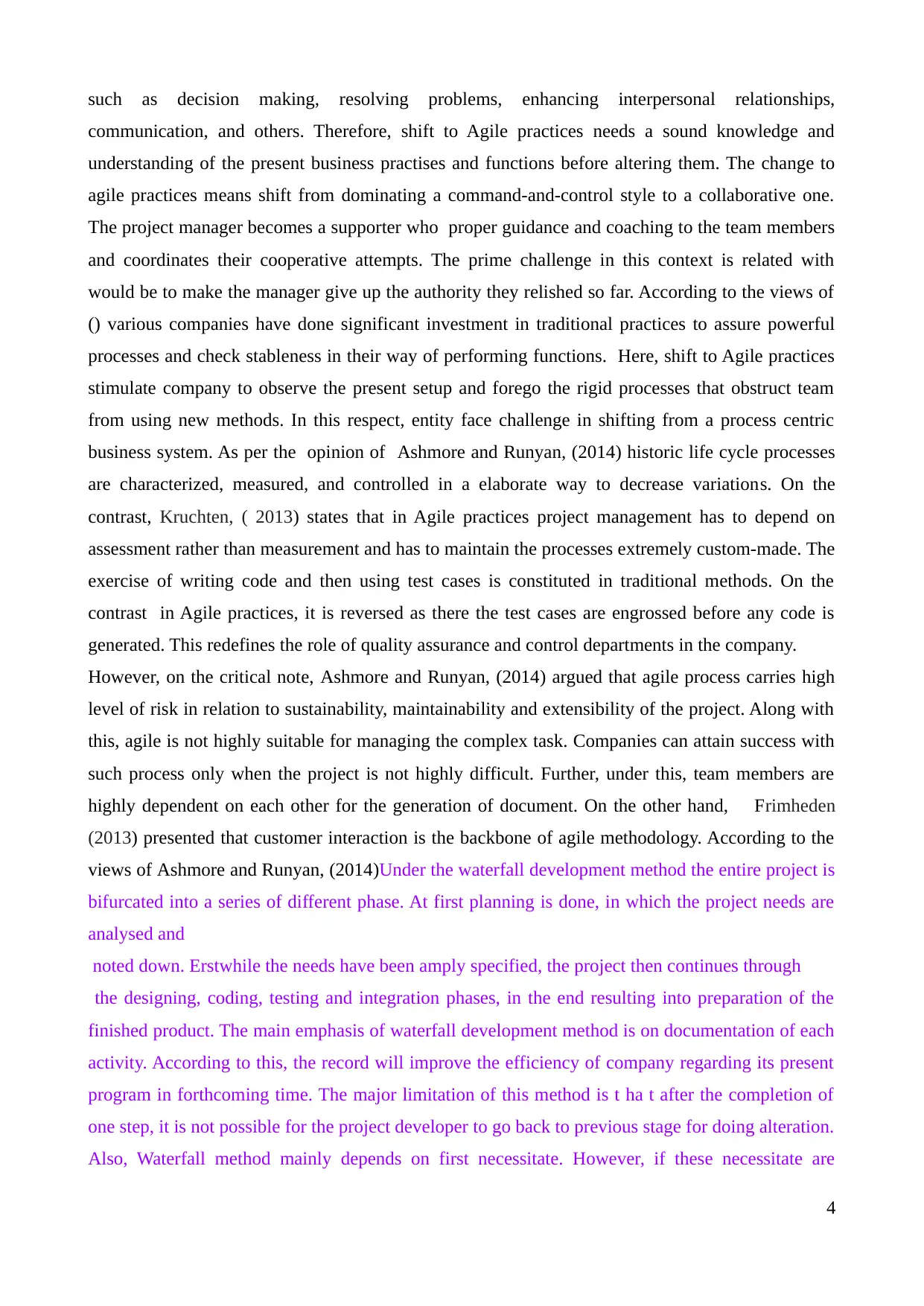
such as decision making, resolving problems, enhancing interpersonal relationships,
communication, and others. Therefore, shift to Agile practices needs a sound knowledge and
understanding of the present business practises and functions before altering them. The change to
agile practices means shift from dominating a command-and-control style to a collaborative one.
The project manager becomes a supporter who proper guidance and coaching to the team members
and coordinates their cooperative attempts. The prime challenge in this context is related with
would be to make the manager give up the authority they relished so far. According to the views of
() various companies have done significant investment in traditional practices to assure powerful
processes and check stableness in their way of performing functions. Here, shift to Agile practices
stimulate company to observe the present setup and forego the rigid processes that obstruct team
from using new methods. In this respect, entity face challenge in shifting from a process centric
business system. As per the opinion of Ashmore and Runyan, (2014) historic life cycle processes
are characterized, measured, and controlled in a elaborate way to decrease variations. On the
contrast, Kruchten, ( 2013) states that in Agile practices project management has to depend on
assessment rather than measurement and has to maintain the processes extremely custom-made. The
exercise of writing code and then using test cases is constituted in traditional methods. On the
contrast in Agile practices, it is reversed as there the test cases are engrossed before any code is
generated. This redefines the role of quality assurance and control departments in the company.
However, on the critical note, Ashmore and Runyan, (2014) argued that agile process carries high
level of risk in relation to sustainability, maintainability and extensibility of the project. Along with
this, agile is not highly suitable for managing the complex task. Companies can attain success with
such process only when the project is not highly difficult. Further, under this, team members are
highly dependent on each other for the generation of document. On the other hand, Frimheden
(2013) presented that customer interaction is the backbone of agile methodology. According to the
views of Ashmore and Runyan, (2014)Under the waterfall development method the entire project is
bifurcated into a series of different phase. At first planning is done, in which the project needs are
analysed and
noted down. Erstwhile the needs have been amply specified, the project then continues through
the designing, coding, testing and integration phases, in the end resulting into preparation of the
finished product. The main emphasis of waterfall development method is on documentation of each
activity. According to this, the record will improve the efficiency of company regarding its present
program in forthcoming time. The major limitation of this method is t ha t after the completion of
one step, it is not possible for the project developer to go back to previous stage for doing alteration.
Also, Waterfall method mainly depends on first necessitate. However, if these necessitate are
4
communication, and others. Therefore, shift to Agile practices needs a sound knowledge and
understanding of the present business practises and functions before altering them. The change to
agile practices means shift from dominating a command-and-control style to a collaborative one.
The project manager becomes a supporter who proper guidance and coaching to the team members
and coordinates their cooperative attempts. The prime challenge in this context is related with
would be to make the manager give up the authority they relished so far. According to the views of
() various companies have done significant investment in traditional practices to assure powerful
processes and check stableness in their way of performing functions. Here, shift to Agile practices
stimulate company to observe the present setup and forego the rigid processes that obstruct team
from using new methods. In this respect, entity face challenge in shifting from a process centric
business system. As per the opinion of Ashmore and Runyan, (2014) historic life cycle processes
are characterized, measured, and controlled in a elaborate way to decrease variations. On the
contrast, Kruchten, ( 2013) states that in Agile practices project management has to depend on
assessment rather than measurement and has to maintain the processes extremely custom-made. The
exercise of writing code and then using test cases is constituted in traditional methods. On the
contrast in Agile practices, it is reversed as there the test cases are engrossed before any code is
generated. This redefines the role of quality assurance and control departments in the company.
However, on the critical note, Ashmore and Runyan, (2014) argued that agile process carries high
level of risk in relation to sustainability, maintainability and extensibility of the project. Along with
this, agile is not highly suitable for managing the complex task. Companies can attain success with
such process only when the project is not highly difficult. Further, under this, team members are
highly dependent on each other for the generation of document. On the other hand, Frimheden
(2013) presented that customer interaction is the backbone of agile methodology. According to the
views of Ashmore and Runyan, (2014)Under the waterfall development method the entire project is
bifurcated into a series of different phase. At first planning is done, in which the project needs are
analysed and
noted down. Erstwhile the needs have been amply specified, the project then continues through
the designing, coding, testing and integration phases, in the end resulting into preparation of the
finished product. The main emphasis of waterfall development method is on documentation of each
activity. According to this, the record will improve the efficiency of company regarding its present
program in forthcoming time. The major limitation of this method is t ha t after the completion of
one step, it is not possible for the project developer to go back to previous stage for doing alteration.
Also, Waterfall method mainly depends on first necessitate. However, if these necessitate are
4
Paraphrase This Document
Need a fresh take? Get an instant paraphrase of this document with our AI Paraphraser
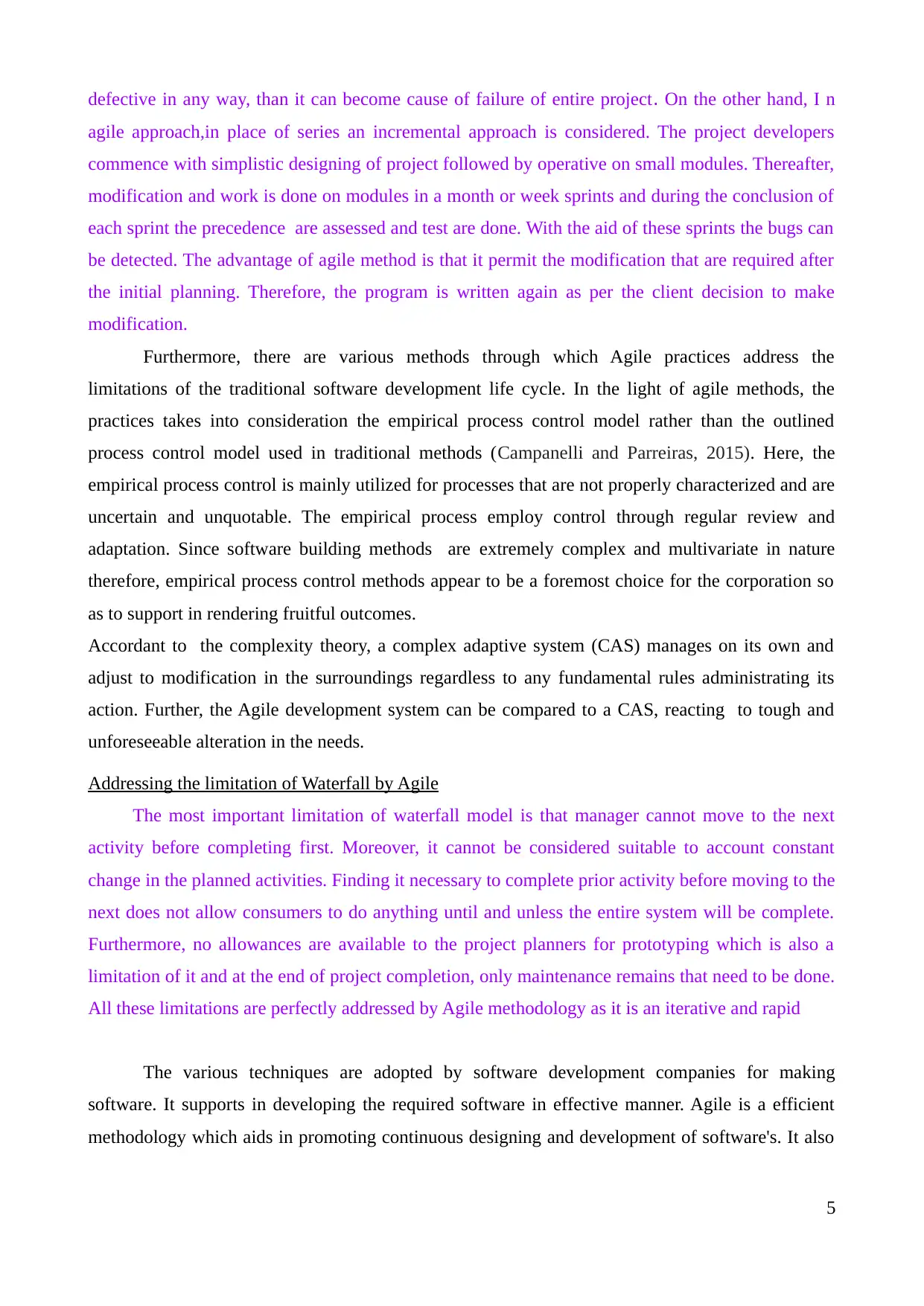
defective in any way, than it can become cause of failure of entire project. On the other hand, I n
agile approach,in place of series an incremental approach is considered. The project developers
commence with simplistic designing of project followed by operative on small modules. Thereafter,
modification and work is done on modules in a month or week sprints and during the conclusion of
each sprint the precedence are assessed and test are done. With the aid of these sprints the bugs can
be detected. The advantage of agile method is that it permit the modification that are required after
the initial planning. Therefore, the program is written again as per the client decision to make
modification.
Furthermore, there are various methods through which Agile practices address the
limitations of the traditional software development life cycle. In the light of agile methods, the
practices takes into consideration the empirical process control model rather than the outlined
process control model used in traditional methods (Campanelli and Parreiras, 2015). Here, the
empirical process control is mainly utilized for processes that are not properly characterized and are
uncertain and unquotable. The empirical process employ control through regular review and
adaptation. Since software building methods are extremely complex and multivariate in nature
therefore, empirical process control methods appear to be a foremost choice for the corporation so
as to support in rendering fruitful outcomes.
Accordant to the complexity theory, a complex adaptive system (CAS) manages on its own and
adjust to modification in the surroundings regardless to any fundamental rules administrating its
action. Further, the Agile development system can be compared to a CAS, reacting to tough and
unforeseeable alteration in the needs.
Addressing the limitation of Waterfall by Agile
The most important limitation of waterfall model is that manager cannot move to the next
activity before completing first. Moreover, it cannot be considered suitable to account constant
change in the planned activities. Finding it necessary to complete prior activity before moving to the
next does not allow consumers to do anything until and unless the entire system will be complete.
Furthermore, no allowances are available to the project planners for prototyping which is also a
limitation of it and at the end of project completion, only maintenance remains that need to be done.
All these limitations are perfectly addressed by Agile methodology as it is an iterative and rapid
The various techniques are adopted by software development companies for making
software. It supports in developing the required software in effective manner. Agile is a efficient
methodology which aids in promoting continuous designing and development of software's. It also
5
agile approach,in place of series an incremental approach is considered. The project developers
commence with simplistic designing of project followed by operative on small modules. Thereafter,
modification and work is done on modules in a month or week sprints and during the conclusion of
each sprint the precedence are assessed and test are done. With the aid of these sprints the bugs can
be detected. The advantage of agile method is that it permit the modification that are required after
the initial planning. Therefore, the program is written again as per the client decision to make
modification.
Furthermore, there are various methods through which Agile practices address the
limitations of the traditional software development life cycle. In the light of agile methods, the
practices takes into consideration the empirical process control model rather than the outlined
process control model used in traditional methods (Campanelli and Parreiras, 2015). Here, the
empirical process control is mainly utilized for processes that are not properly characterized and are
uncertain and unquotable. The empirical process employ control through regular review and
adaptation. Since software building methods are extremely complex and multivariate in nature
therefore, empirical process control methods appear to be a foremost choice for the corporation so
as to support in rendering fruitful outcomes.
Accordant to the complexity theory, a complex adaptive system (CAS) manages on its own and
adjust to modification in the surroundings regardless to any fundamental rules administrating its
action. Further, the Agile development system can be compared to a CAS, reacting to tough and
unforeseeable alteration in the needs.
Addressing the limitation of Waterfall by Agile
The most important limitation of waterfall model is that manager cannot move to the next
activity before completing first. Moreover, it cannot be considered suitable to account constant
change in the planned activities. Finding it necessary to complete prior activity before moving to the
next does not allow consumers to do anything until and unless the entire system will be complete.
Furthermore, no allowances are available to the project planners for prototyping which is also a
limitation of it and at the end of project completion, only maintenance remains that need to be done.
All these limitations are perfectly addressed by Agile methodology as it is an iterative and rapid
The various techniques are adopted by software development companies for making
software. It supports in developing the required software in effective manner. Agile is a efficient
methodology which aids in promoting continuous designing and development of software's. It also
5
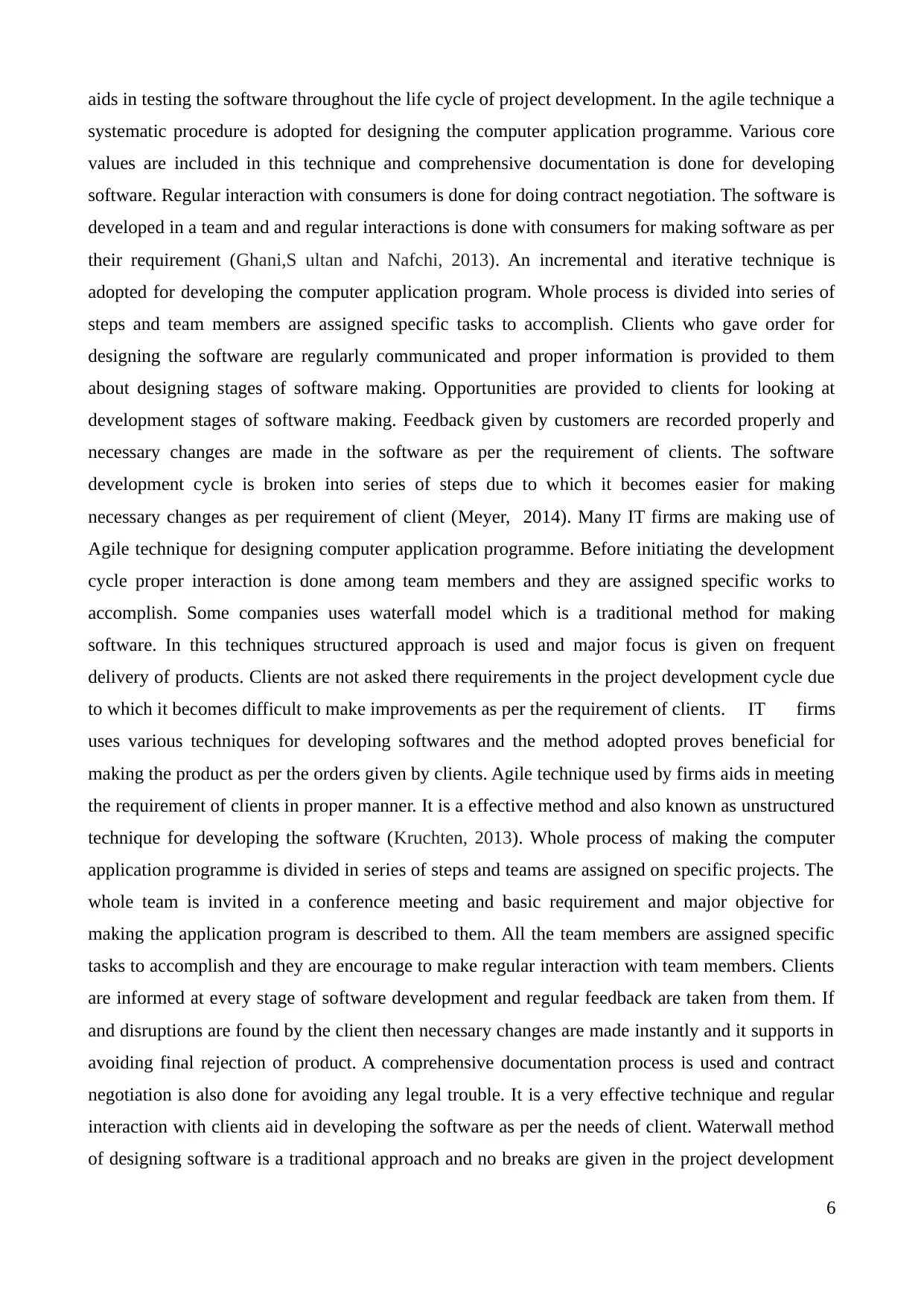
aids in testing the software throughout the life cycle of project development. In the agile technique a
systematic procedure is adopted for designing the computer application programme. Various core
values are included in this technique and comprehensive documentation is done for developing
software. Regular interaction with consumers is done for doing contract negotiation. The software is
developed in a team and and regular interactions is done with consumers for making software as per
their requirement (Ghani,S ultan and Nafchi, 2013). An incremental and iterative technique is
adopted for developing the computer application program. Whole process is divided into series of
steps and team members are assigned specific tasks to accomplish. Clients who gave order for
designing the software are regularly communicated and proper information is provided to them
about designing stages of software making. Opportunities are provided to clients for looking at
development stages of software making. Feedback given by customers are recorded properly and
necessary changes are made in the software as per the requirement of clients. The software
development cycle is broken into series of steps due to which it becomes easier for making
necessary changes as per requirement of client (Meyer, 2014). Many IT firms are making use of
Agile technique for designing computer application programme. Before initiating the development
cycle proper interaction is done among team members and they are assigned specific works to
accomplish. Some companies uses waterfall model which is a traditional method for making
software. In this techniques structured approach is used and major focus is given on frequent
delivery of products. Clients are not asked there requirements in the project development cycle due
to which it becomes difficult to make improvements as per the requirement of clients. IT firms
uses various techniques for developing softwares and the method adopted proves beneficial for
making the product as per the orders given by clients. Agile technique used by firms aids in meeting
the requirement of clients in proper manner. It is a effective method and also known as unstructured
technique for developing the software (Kruchten, 2013). Whole process of making the computer
application programme is divided in series of steps and teams are assigned on specific projects. The
whole team is invited in a conference meeting and basic requirement and major objective for
making the application program is described to them. All the team members are assigned specific
tasks to accomplish and they are encourage to make regular interaction with team members. Clients
are informed at every stage of software development and regular feedback are taken from them. If
and disruptions are found by the client then necessary changes are made instantly and it supports in
avoiding final rejection of product. A comprehensive documentation process is used and contract
negotiation is also done for avoiding any legal trouble. It is a very effective technique and regular
interaction with clients aid in developing the software as per the needs of client. Waterwall method
of designing software is a traditional approach and no breaks are given in the project development
6
systematic procedure is adopted for designing the computer application programme. Various core
values are included in this technique and comprehensive documentation is done for developing
software. Regular interaction with consumers is done for doing contract negotiation. The software is
developed in a team and and regular interactions is done with consumers for making software as per
their requirement (Ghani,S ultan and Nafchi, 2013). An incremental and iterative technique is
adopted for developing the computer application program. Whole process is divided into series of
steps and team members are assigned specific tasks to accomplish. Clients who gave order for
designing the software are regularly communicated and proper information is provided to them
about designing stages of software making. Opportunities are provided to clients for looking at
development stages of software making. Feedback given by customers are recorded properly and
necessary changes are made in the software as per the requirement of clients. The software
development cycle is broken into series of steps due to which it becomes easier for making
necessary changes as per requirement of client (Meyer, 2014). Many IT firms are making use of
Agile technique for designing computer application programme. Before initiating the development
cycle proper interaction is done among team members and they are assigned specific works to
accomplish. Some companies uses waterfall model which is a traditional method for making
software. In this techniques structured approach is used and major focus is given on frequent
delivery of products. Clients are not asked there requirements in the project development cycle due
to which it becomes difficult to make improvements as per the requirement of clients. IT firms
uses various techniques for developing softwares and the method adopted proves beneficial for
making the product as per the orders given by clients. Agile technique used by firms aids in meeting
the requirement of clients in proper manner. It is a effective method and also known as unstructured
technique for developing the software (Kruchten, 2013). Whole process of making the computer
application programme is divided in series of steps and teams are assigned on specific projects. The
whole team is invited in a conference meeting and basic requirement and major objective for
making the application program is described to them. All the team members are assigned specific
tasks to accomplish and they are encourage to make regular interaction with team members. Clients
are informed at every stage of software development and regular feedback are taken from them. If
and disruptions are found by the client then necessary changes are made instantly and it supports in
avoiding final rejection of product. A comprehensive documentation process is used and contract
negotiation is also done for avoiding any legal trouble. It is a very effective technique and regular
interaction with clients aid in developing the software as per the needs of client. Waterwall method
of designing software is a traditional approach and no breaks are given in the project development
6
⊘ This is a preview!⊘
Do you want full access?
Subscribe today to unlock all pages.

Trusted by 1+ million students worldwide
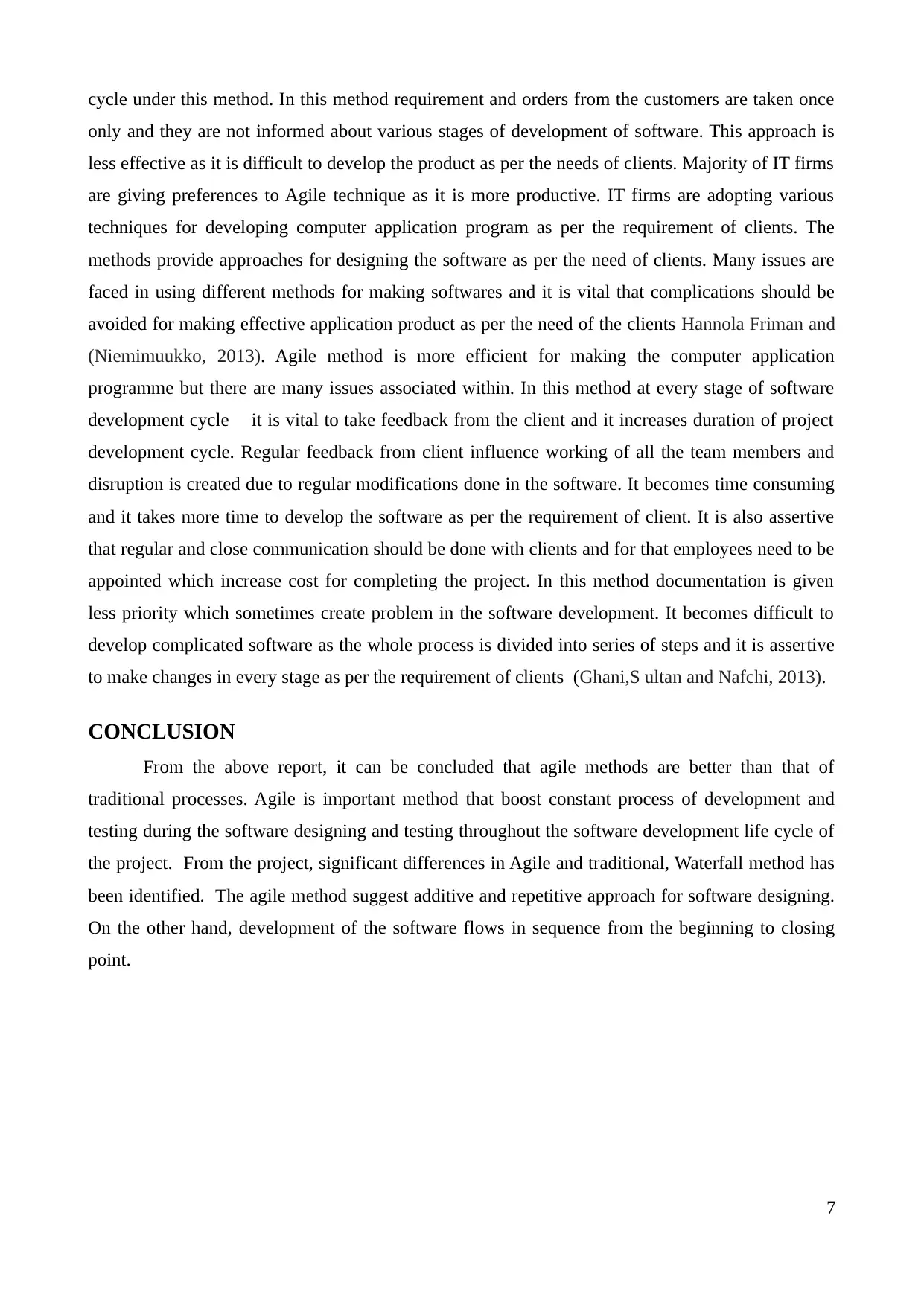
cycle under this method. In this method requirement and orders from the customers are taken once
only and they are not informed about various stages of development of software. This approach is
less effective as it is difficult to develop the product as per the needs of clients. Majority of IT firms
are giving preferences to Agile technique as it is more productive. IT firms are adopting various
techniques for developing computer application program as per the requirement of clients. The
methods provide approaches for designing the software as per the need of clients. Many issues are
faced in using different methods for making softwares and it is vital that complications should be
avoided for making effective application product as per the need of the clients Hannola Friman and
(Niemimuukko, 2013). Agile method is more efficient for making the computer application
programme but there are many issues associated within. In this method at every stage of software
development cycle it is vital to take feedback from the client and it increases duration of project
development cycle. Regular feedback from client influence working of all the team members and
disruption is created due to regular modifications done in the software. It becomes time consuming
and it takes more time to develop the software as per the requirement of client. It is also assertive
that regular and close communication should be done with clients and for that employees need to be
appointed which increase cost for completing the project. In this method documentation is given
less priority which sometimes create problem in the software development. It becomes difficult to
develop complicated software as the whole process is divided into series of steps and it is assertive
to make changes in every stage as per the requirement of clients (Ghani,S ultan and Nafchi, 2013).
CONCLUSION
From the above report, it can be concluded that agile methods are better than that of
traditional processes. Agile is important method that boost constant process of development and
testing during the software designing and testing throughout the software development life cycle of
the project. From the project, significant differences in Agile and traditional, Waterfall method has
been identified. The agile method suggest additive and repetitive approach for software designing.
On the other hand, development of the software flows in sequence from the beginning to closing
point.
7
only and they are not informed about various stages of development of software. This approach is
less effective as it is difficult to develop the product as per the needs of clients. Majority of IT firms
are giving preferences to Agile technique as it is more productive. IT firms are adopting various
techniques for developing computer application program as per the requirement of clients. The
methods provide approaches for designing the software as per the need of clients. Many issues are
faced in using different methods for making softwares and it is vital that complications should be
avoided for making effective application product as per the need of the clients Hannola Friman and
(Niemimuukko, 2013). Agile method is more efficient for making the computer application
programme but there are many issues associated within. In this method at every stage of software
development cycle it is vital to take feedback from the client and it increases duration of project
development cycle. Regular feedback from client influence working of all the team members and
disruption is created due to regular modifications done in the software. It becomes time consuming
and it takes more time to develop the software as per the requirement of client. It is also assertive
that regular and close communication should be done with clients and for that employees need to be
appointed which increase cost for completing the project. In this method documentation is given
less priority which sometimes create problem in the software development. It becomes difficult to
develop complicated software as the whole process is divided into series of steps and it is assertive
to make changes in every stage as per the requirement of clients (Ghani,S ultan and Nafchi, 2013).
CONCLUSION
From the above report, it can be concluded that agile methods are better than that of
traditional processes. Agile is important method that boost constant process of development and
testing during the software designing and testing throughout the software development life cycle of
the project. From the project, significant differences in Agile and traditional, Waterfall method has
been identified. The agile method suggest additive and repetitive approach for software designing.
On the other hand, development of the software flows in sequence from the beginning to closing
point.
7
Paraphrase This Document
Need a fresh take? Get an instant paraphrase of this document with our AI Paraphraser
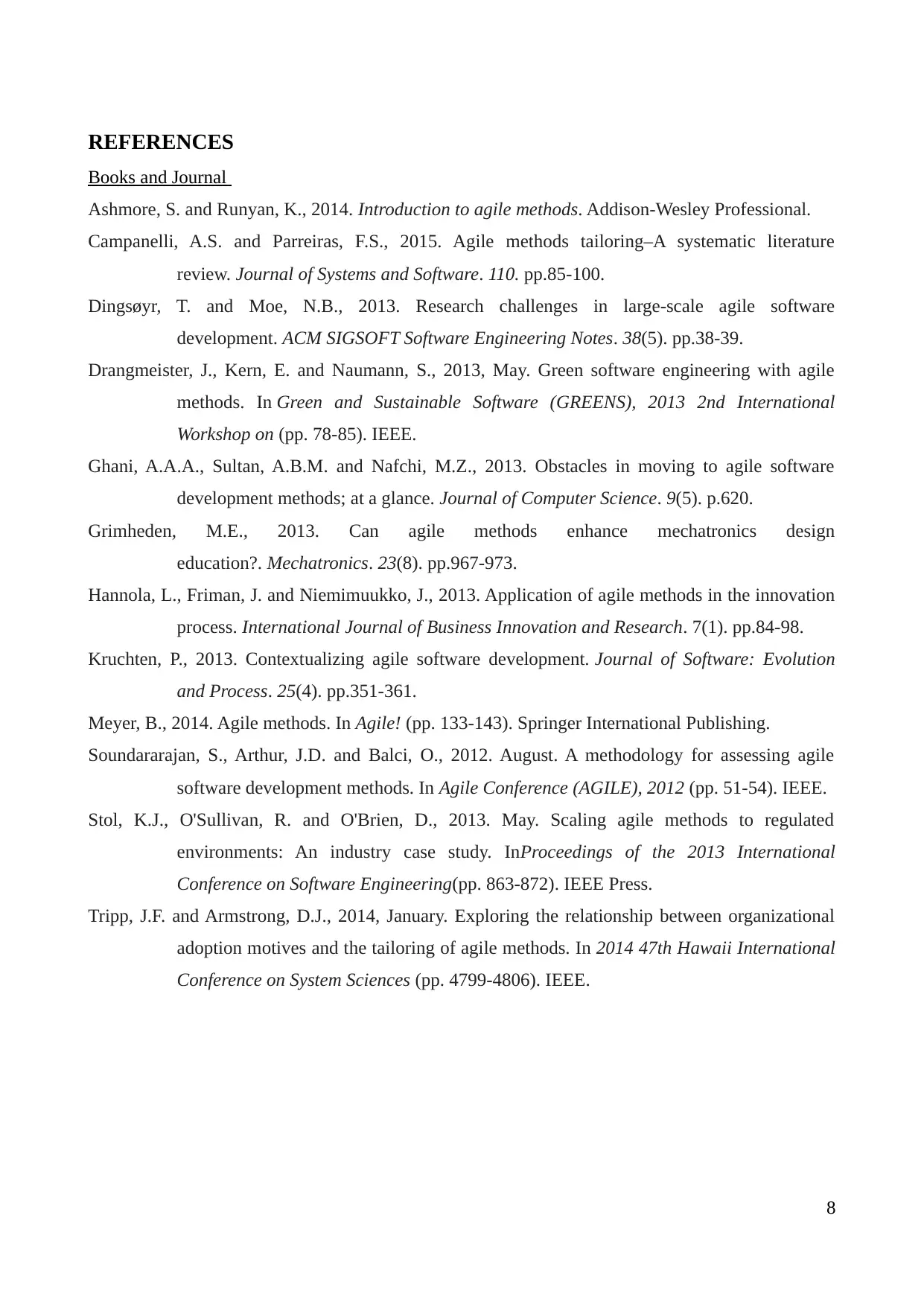
REFERENCES
Books and Journal
Ashmore, S. and Runyan, K., 2014. Introduction to agile methods. Addison-Wesley Professional.
Campanelli, A.S. and Parreiras, F.S., 2015. Agile methods tailoring–A systematic literature
review. Journal of Systems and Software. 110. pp.85-100.
Dingsøyr, T. and Moe, N.B., 2013. Research challenges in large-scale agile software
development. ACM SIGSOFT Software Engineering Notes. 38(5). pp.38-39.
Drangmeister, J., Kern, E. and Naumann, S., 2013, May. Green software engineering with agile
methods. In Green and Sustainable Software (GREENS), 2013 2nd International
Workshop on (pp. 78-85). IEEE.
Ghani, A.A.A., Sultan, A.B.M. and Nafchi, M.Z., 2013. Obstacles in moving to agile software
development methods; at a glance. Journal of Computer Science. 9(5). p.620.
Grimheden, M.E., 2013. Can agile methods enhance mechatronics design
education?. Mechatronics. 23(8). pp.967-973.
Hannola, L., Friman, J. and Niemimuukko, J., 2013. Application of agile methods in the innovation
process. International Journal of Business Innovation and Research. 7(1). pp.84-98.
Kruchten, P., 2013. Contextualizing agile software development. Journal of Software: Evolution
and Process. 25(4). pp.351-361.
Meyer, B., 2014. Agile methods. In Agile! (pp. 133-143). Springer International Publishing.
Soundararajan, S., Arthur, J.D. and Balci, O., 2012. August. A methodology for assessing agile
software development methods. In Agile Conference (AGILE), 2012 (pp. 51-54). IEEE.
Stol, K.J., O'Sullivan, R. and O'Brien, D., 2013. May. Scaling agile methods to regulated
environments: An industry case study. InProceedings of the 2013 International
Conference on Software Engineering(pp. 863-872). IEEE Press.
Tripp, J.F. and Armstrong, D.J., 2014, January. Exploring the relationship between organizational
adoption motives and the tailoring of agile methods. In 2014 47th Hawaii International
Conference on System Sciences (pp. 4799-4806). IEEE.
8
Books and Journal
Ashmore, S. and Runyan, K., 2014. Introduction to agile methods. Addison-Wesley Professional.
Campanelli, A.S. and Parreiras, F.S., 2015. Agile methods tailoring–A systematic literature
review. Journal of Systems and Software. 110. pp.85-100.
Dingsøyr, T. and Moe, N.B., 2013. Research challenges in large-scale agile software
development. ACM SIGSOFT Software Engineering Notes. 38(5). pp.38-39.
Drangmeister, J., Kern, E. and Naumann, S., 2013, May. Green software engineering with agile
methods. In Green and Sustainable Software (GREENS), 2013 2nd International
Workshop on (pp. 78-85). IEEE.
Ghani, A.A.A., Sultan, A.B.M. and Nafchi, M.Z., 2013. Obstacles in moving to agile software
development methods; at a glance. Journal of Computer Science. 9(5). p.620.
Grimheden, M.E., 2013. Can agile methods enhance mechatronics design
education?. Mechatronics. 23(8). pp.967-973.
Hannola, L., Friman, J. and Niemimuukko, J., 2013. Application of agile methods in the innovation
process. International Journal of Business Innovation and Research. 7(1). pp.84-98.
Kruchten, P., 2013. Contextualizing agile software development. Journal of Software: Evolution
and Process. 25(4). pp.351-361.
Meyer, B., 2014. Agile methods. In Agile! (pp. 133-143). Springer International Publishing.
Soundararajan, S., Arthur, J.D. and Balci, O., 2012. August. A methodology for assessing agile
software development methods. In Agile Conference (AGILE), 2012 (pp. 51-54). IEEE.
Stol, K.J., O'Sullivan, R. and O'Brien, D., 2013. May. Scaling agile methods to regulated
environments: An industry case study. InProceedings of the 2013 International
Conference on Software Engineering(pp. 863-872). IEEE Press.
Tripp, J.F. and Armstrong, D.J., 2014, January. Exploring the relationship between organizational
adoption motives and the tailoring of agile methods. In 2014 47th Hawaii International
Conference on System Sciences (pp. 4799-4806). IEEE.
8
1 out of 8
Related Documents
Your All-in-One AI-Powered Toolkit for Academic Success.
+13062052269
info@desklib.com
Available 24*7 on WhatsApp / Email
![[object Object]](/_next/static/media/star-bottom.7253800d.svg)
Unlock your academic potential
Copyright © 2020–2025 A2Z Services. All Rights Reserved. Developed and managed by ZUCOL.




